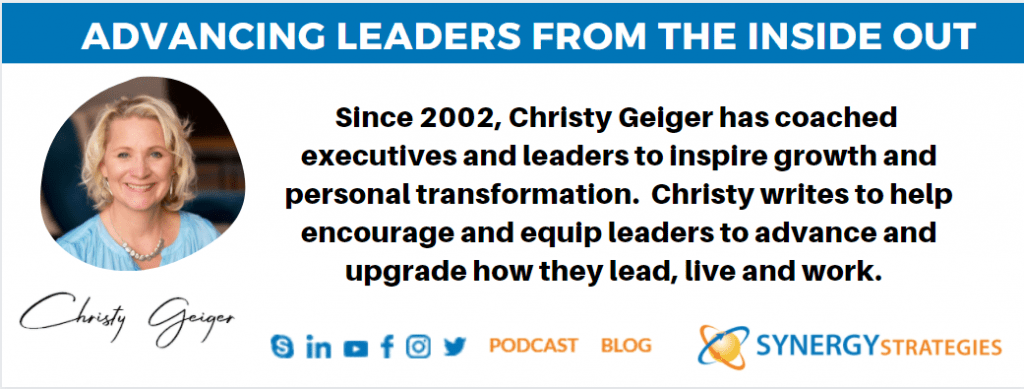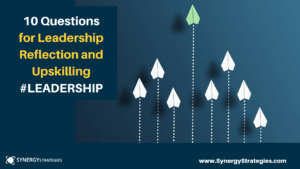The International Coaching Federation (ICF) defines coaching as “partnering with clients in a thought-provoking and creative process that inspires them to maximize their personal and professional potential.”
CTI (www.coactive.com), where I was initially trained in coaching skills in 2002, describes coaching as DEEPENING LEARNING while FORWARDING ACTION, while both BEING and DOING. It is about greater awareness, with an intention to lean into our personal power and create for the sake of positive impact in the world each day. To do this requires the ongoing process and journey to know and understand ourselves, and our impact, as well as a commitment to upskilling our emotions, thoughts, beliefs, and activity.
So how does coaching work to help deepen this awareness, transform, and advance how we show up in the world? Early in my coaching career, a consultant challenged me to define my model for coaching. It was challenging because coaching is organic and unique to the individual client. The client determines what they want to dig into, and where they want to grow, and we dynamically dance with them in that moment. As a result, my style of coaching intentionally does not have a worksheet, recipe, or process to have a client walk through. While I use many tools in coaching, they are also dynamic as they apply to each situation. The inquiry to define how I work, however, was useful and valuable to define. I developed a model to help capture the numerous components happening and available in my coaching process. This is what I call the Synergy Strategies Coaching Model. It does not mean these happen in each coaching call, rather these are all on the table to be accessed and part of a coaching relationship.
Each coaching call starts with you, the client, in the center. Coaching is about the client, where they are, and where they want to go (their desired goal/future). Also in the center is your coach, Synergy Strategies, to dance together with you by focusing on what is important to you and creating space to gain insight, and find clarity, focus, and a plan for action.
We follow four main themes:
- Tangible – where you desire to go and how to get there
- Intangible – our emotions, thoughts, and beliefs which affect our behavior
- Concrete– our surroundings, resources, and the physical parts of our life that can affect and be designed to support our desired goals
- Abstract – understanding who we are by designing our innate and internal approach to accomplish what we want/desire
Each of the themes has two contributing forces:
Tangible
- Direction: Vision, Mission, Values, Goals = Your personal vision and mission for your life or business along with the values and goals to which you aspire.
- Strategy: Objectives, Planning, Action, Results = What you are out to accomplish, how you will do it, and strategies to stay in action and accomplish what you want faster.
Intangible
- Ideas, Thoughts, Beliefs = How you think. (Self-esteem, rhino spirit, gremlins, confidence, endurance, self-discipline, etc.)
- Behavior, Actions, Habits = How you operate. (Effectiveness, tolerations, habits, time management, etc.)
Concrete
- Designed Environments: Leveraging every part of your surroundings to allow your goals to happen easily and effortlessly (7 parts = Relationships, Intangible, Self, Network, Nature, Memetic, and Physical Space)
- Overall Life Balance: Recognizing and designing balance in each part of your life so no part holds you back from your goals and all parts complement and enhance your life’s mission and purpose (8 parts = Career, Finances, Fitness/Health, Fun, Faith/Personal Growth, Relationships (Family/Friends & Business Partner), Physical Environment, and Friends/Family)
Abstract (note while assessments are concrete, what assessments are used to measure is abstract; while a routine can be concrete the design and purpose desired from a routine is more abstract and hard to quantify)
- Tools: Assessments & Measurements: Instruments used to assess where you are and learn to better yourself.
- Systems: Accountability & Routines: Designing methods that help you to accomplish what is important.
Coaching brings much more to the table that is difficult to quantify. Invisible and internal growth lends to external changes and results. These are a few components, however, that are integral to transformation. When we allow ourselves to explore and grow in these four areas, we can experience significant shifts in our internal and external circumstances and realities.
- Tangible – What is your desire for yourself? Where do you want to go? What do you want to achieve?
- Intangible – How do your mindset, perspective, and wiring influence how you see yourself and the world?
- Concrete – What is in your environment that supports or distracts from your desires and goals?
- Abstract – How can you stand more in your strengths and personal power to achieve your goals?
Are you clear on what you want and what you are working to create? Are you using all these areas to accomplish your goals?
If you were to include another area in your growth and transformation, which could you embrace and develop more?
Here is to you and your journey. It is exciting to be able to increase our awareness, tap more of our potential and expand our impact as we grow and learn.
SUMMARY …
Definition of the Synergy Strategies Model:
We have found that the eight components above are all essential elements to successful entrepreneurship and personal development. Whatever stage of life you are in (determining your life’s course, starting a business, or running a company or non-profit), leaders will be more successful when they are cognizant and vigilant about each of these eight key areas. Coaching assists you in bringing synergy to all these areas so you can maximize your full potential and exceed your goals.
- Blue ball in the middle = Your Life
- SS in the middle = You and your coach working together to bring each part of your life into synergy with each other.
- Direction: Vision, Mission, Values, Goals = Your personal vision and mission for your life or business along with the values and goals to which you aspire.
- Strategy: Objectives, Planning, Action, Results = What you are out to accomplish, how you will do it, and strategies to stay in action and accomplish what you want faster.
- Ideas, Thoughts, Beliefs = How you think. (Self-esteem, rhino spirit, gremlins, confidence, endurance, self-discipline, etc.)
- Behavior, Actions, Habits = How you operate. (Effectiveness, tolerations, habits, time management, etc.)
- Designed Environments: How to design and leverage every part of your surroundings to allow your goals to happen easily and effortlessly (7 parts = Relationships, Intangible, Self, Network, Nature, Memetic, and Physical Space)
- Overall Life Balance: How to have balance in each part of your life so no part holds you back from your goals and all parts compliment and enhance your life’s mission and purpose (8 parts = Career, Finances, Fitness/Health, Fun, Faith/Personal Growth, Relationships (Family/Friends & Business Partner), Physical Environment, and Friends/Family)
- Tools: Assessments & Measurements: Instruments used to assess where you are and learn to better yourself.
- Systems: Accountability & Routines: Designing methods that help you to accomplish what is important.






